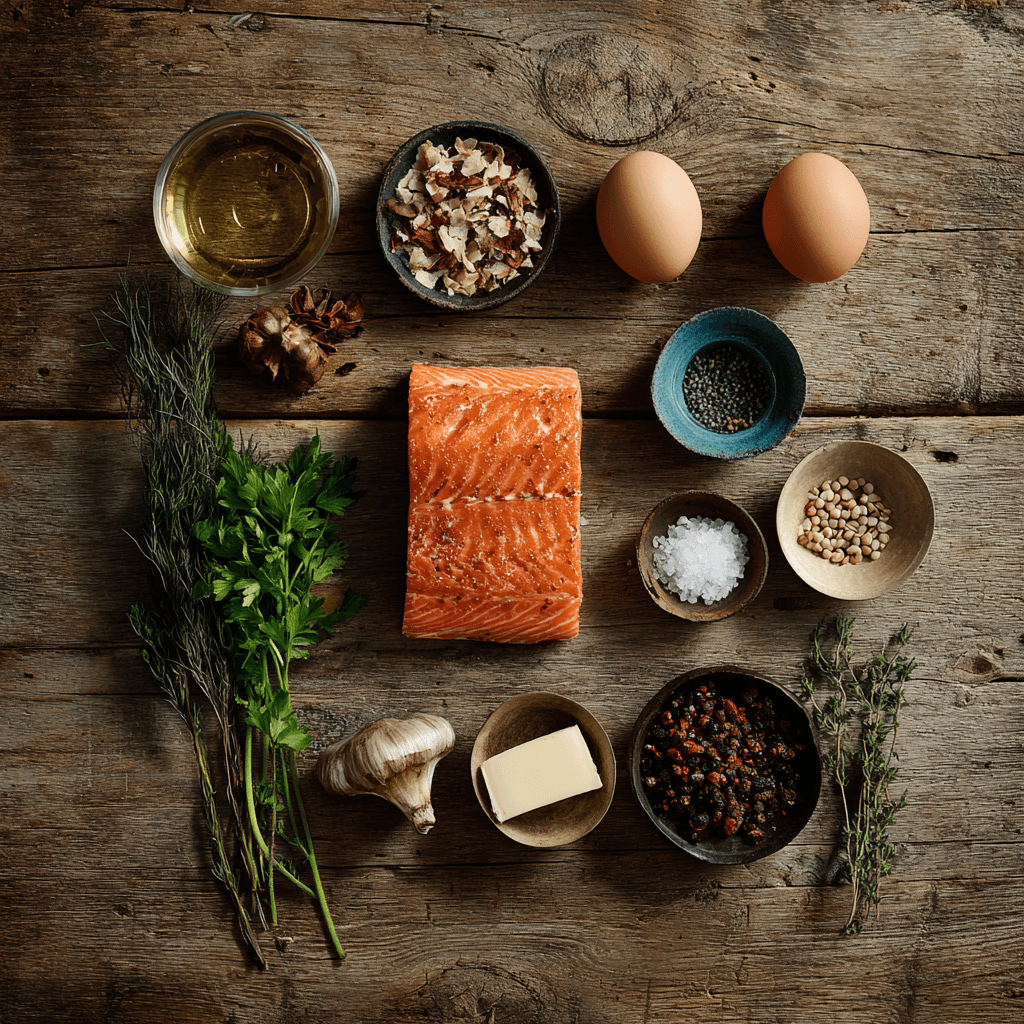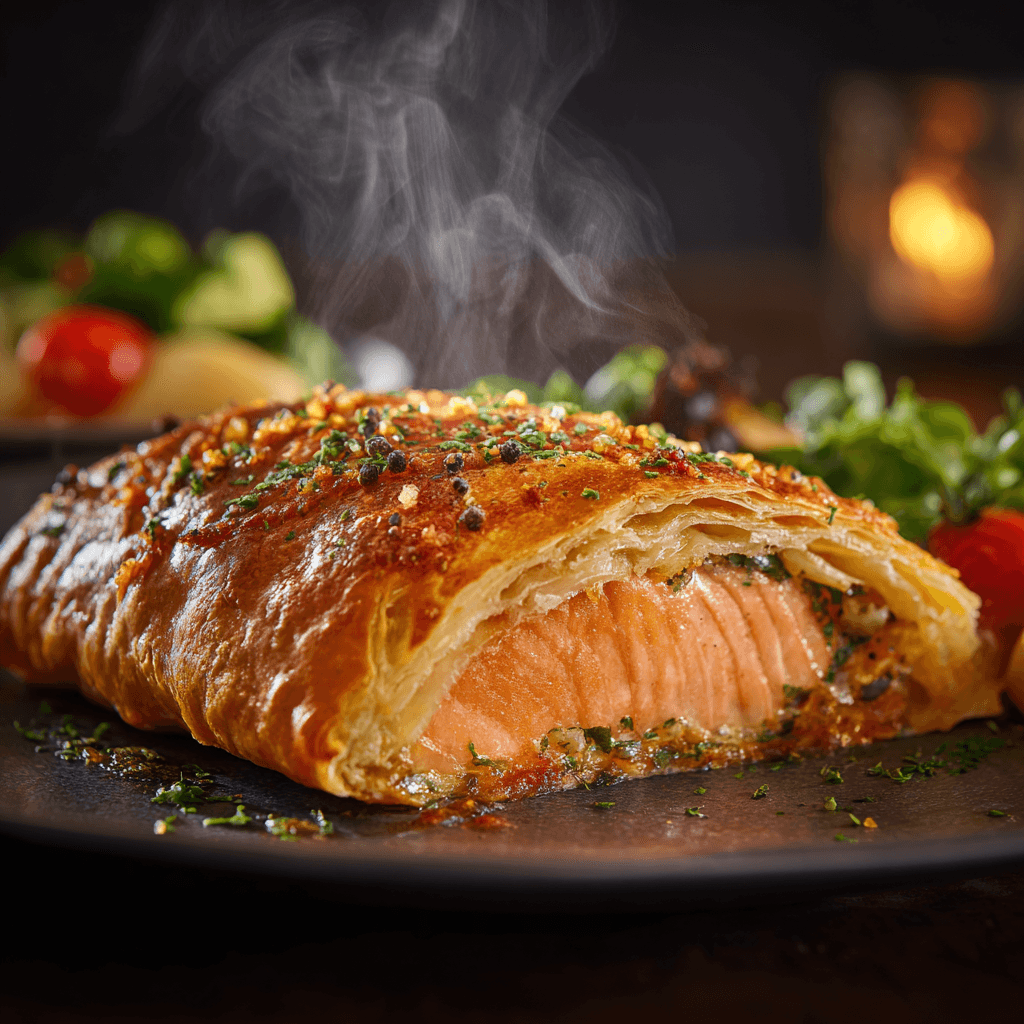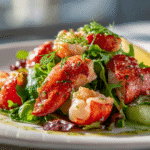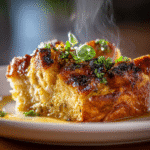Table of Contents
Gordon Ramsay Salmon Wellington transforms ordinary salmon into something extraordinary, but here’s what most home cooks don’t realize: the difference between a soggy disappointment and a restaurant-quality masterpiece comes down to three critical techniques I learned during my years cooking for hungry firefighters. Back at the station, we’d attempt fancy dishes for special occasions, and I watched more than one ambitious cook end up with pastry that looked like it survived a house fire. The key isn’t just following a recipe—it’s understanding the science behind moisture control and pastry structure. According to FDA guidelines for seafood safety, proper cooking techniques not only ensure delicious results but also food safety. If you’re looking to master similar wrapped techniques, you might also enjoy our Gordon Ramsay Turkey Wellington guide.
Why This Gordon Ramsay Salmon Wellington Recipe Works (And Where Most Go Wrong)
After watching countless home cooks struggle with soggy bottoms and overcooked fish, I’ve identified the three principles that separate success from disaster. First is the moisture barrier technique—most people skip the crucial step of creating a protective layer between the salmon and pastry. Gordon Ramsay always emphasizes this in his professional kitchens, and food science research confirms that proteins release moisture as they cook, which can destroy pastry structure.
The second principle is temperature control throughout the process. Many home cooks try to rush by using room temperature ingredients, but this Gordon Ramsay Salmon Wellington requires specific temperature staging. Your salmon should be cold, your pastry should be chilled, and your oven needs proper preheating. The third critical element is the sealing technique—improper edge sealing leads to filling leakage and structural collapse during baking.
Ingredients That Actually Matter for Gordon Ramsay Salmon Wellington

The salmon selection makes or breaks this dish. You need a center-cut fillet, about 2 pounds, with consistent thickness throughout. Wild-caught salmon works best because it has firmer flesh and less water content than farm-raised varieties. Look for bright color and firm texture—if it leaves an indentation when pressed, it’s too soft for this Gordon Ramsay Salmon Wellington technique.
For the pastry, frozen puff pastry actually works better than homemade for most home cooks. The industrial lamination process creates more consistent layers, and brands like Pepperidge Farm have the right butter content. You’ll also need fresh dill, cream cheese for the moisture barrier, and Dijon mustard for flavor depth. The duxelles mixture requires button mushrooms, shallots, and fresh thyme—dried herbs won’t provide the same intensity. Consider pairing this with our Gordon Ramsay Grilled Salmon techniques for comparison.
Step-by-Step Instructions for Gordon Ramsay Salmon Wellington
Preparing the Salmon Base
Start by patting your salmon completely dry with paper towels, then season with salt and pepper. Heat a heavy-bottomed pan over high heat and sear the salmon for 90 seconds on each side—you want color but not full cooking. Warning: The pan will be extremely hot, keep pot holders nearby and never leave unattended. Remove and let cool completely in the refrigerator for at least 30 minutes.
Creating the Mushroom Duxelles
Pulse mushrooms in a food processor until finely chopped but not pureed. Sauté with minced shallots in a dry pan until all moisture evaporates—this takes about 8-10 minutes and is crucial for preventing soggy pastry. The mixture should look dry and smell intensely mushroom-forward. Cool completely before assembly.
Assembly and Baking
Roll your thawed puff pastry into a rectangle large enough to wrap the salmon with 2-inch borders. Spread a thin layer of cream cheese down the center, leaving borders clear. Place the cooled duxelles over the cream cheese, then position the salmon on top. Brush pastry edges with beaten egg, then wrap tightly, sealing all edges with fork pressure. Critical safety point: Ensure your oven is preheated to exactly 400°F before baking—temperature accuracy is essential for food safety. Brush the entire surface with egg wash and score decorative lines if desired. Bake for 25-30 minutes until golden brown and internal temperature reaches 145°F. For more detailed pastry techniques, check out our guide on professional bread making secrets.
Pro-Tips That Change the Game
- Chill the assembled Wellington for 15 minutes before baking—this helps maintain pastry structure and prevents spreading
- Use a pizza stone or inverted baking sheet in the bottom third of your oven to create bottom heat and prevent soggy bottoms
- Score the pastry with shallow cuts before baking to prevent random cracking and create professional presentation
- Let rest for 5 minutes after baking before slicing—this allows juices to redistribute and prevents filling from running out
- Use a sharp serrated knife in a sawing motion rather than pressing down to maintain pastry integrity when slicing
- Make extra duxelles and freeze it—this component takes the most time and having it ready makes future Wellingtons much faster
Storage & Leftovers for Gordon Ramsay Salmon Wellington
Store leftover Gordon Ramsay Salmon Wellington in the refrigerator for up to 2 days, wrapped tightly in aluminum foil. For food safety, refrigerate within 2 hours of cooking and maintain temperatures below 40°F. Reheat individual portions in a 350°F oven for 10-12 minutes rather than using the microwave, which will make the pastry soggy.
Freezing isn’t recommended for cooked Wellington as the pastry texture deteriorates significantly. However, you can assemble the raw Wellington and freeze for up to 1 month. Bake directly from frozen, adding 10-15 minutes to the cooking time. According to FDA storage guidelines, always use a food thermometer to verify the internal temperature reaches 145°F when reheating.

Gordon Ramsay Salmon Wellington
Ingredients
Equipment
Method
- 1️⃣ Pat salmon completely dry with paper towels and season with salt and pepper. Heat heavy-bottomed pan over high heat and sear salmon for 90 seconds on each side to develop color without full cooking. Remove and refrigerate for 30 minutes to cool completely.
- 2️⃣ Pulse mushrooms in food processor until finely chopped but not pureed. Sauté with minced shallots in a dry pan for 8-10 minutes until all moisture evaporates and mixture looks dry with intense mushroom aroma. Cool completely.
- 3️⃣ Preheat oven to exactly 400°F. Roll thawed puff pastry into rectangle large enough to wrap salmon with 2-inch borders on all sides.
- 4️⃣ Spread thin layer of cream cheese down center of pastry, leaving borders clear. Layer cooled mushroom duxelles over cream cheese, then position cooled salmon on top.
- 5️⃣ Brush pastry edges with beaten egg, then wrap tightly around salmon. Seal all edges with fork pressure, ensuring no gaps remain.
- 6️⃣ Chill assembled Wellington for 15 minutes. Brush entire surface with egg wash and score shallow decorative lines if desired.
- 7️⃣ Bake for 25-30 minutes until golden brown and internal temperature reaches 145°F. Let rest 5 minutes before slicing with sharp serrated knife using sawing motion.
Nutrition
Notes
Tried this recipe?
Let us know how it was!Frequently Asked Questions About Gordon Ramsay Salmon Wellington
What has Gordon Ramsay been diagnosed with?
Gordon Ramsay has been open about his arthritis diagnosis, which affects his hands and joints from years of professional cooking. Despite this challenge, he continues to demonstrate precise knife skills and cooking techniques. This Gordon Ramsay Salmon Wellington recipe incorporates his adapted methods that reduce repetitive strain while maintaining professional standards.
What sauce goes best with Salmon Wellington?
A classic hollandaise or lemon butter sauce pairs beautifully with Gordon Ramsay Salmon Wellington. The rich, creamy texture complements the flaky pastry and tender salmon. Alternatively, a light dill cream sauce or even our Gordon Ramsay Green Peppercorn Sauce provides excellent flavor contrast. Avoid heavy tomato-based sauces that compete with the delicate fish flavors.
Does Gordon Ramsay ever apologize?
Yes, Gordon Ramsay has publicly apologized several times throughout his career, particularly regarding past mistakes or overly harsh criticism. In his cooking philosophy, he emphasizes learning from errors rather than repeating them. This approach applies perfectly to mastering Gordon Ramsay Salmon Wellington—expect some failures while developing technique, and view each attempt as valuable learning experience.
How does Gordon Ramsay cook salmon perfectly?
Gordon Ramsay’s salmon technique focuses on high heat searing followed by gentle finishing. He preheats pans properly, uses minimal oil, and never moves the fish until it releases naturally. For this Gordon Ramsay Salmon Wellington, the initial sear creates flavor while the pastry provides gentle, even heat distribution. The key is starting with room temperature fish and avoiding overcooking during the searing phase.
This Gordon Ramsay Salmon Wellington represents everything I love about cooking—combining technique with creativity to transform simple ingredients into something memorable. Don’t be discouraged if your first attempt isn’t perfect; even in professional kitchens, Wellington dishes require practice to master.
Stay safe,
Jack Sullivan


